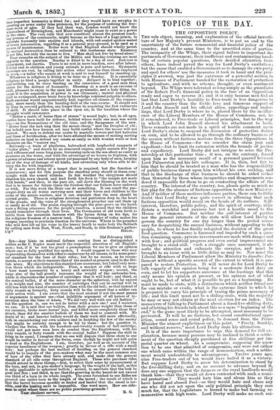22d February 1852.
Sia—Any hints on national defence coming from so distinguished a soldier as fkr C. Napier must merit the respectful attention of all English- men; but, if it be not too great a presumption for me to give an opinion where one so fully qualified has spoken, I would suggest to those who may be providing themselves with rifles to endeavour by all means, to fix some gene- ral standard for the bore of their rifles; but by no means, as he recom- mends, to accept as their measure that of the musket at present used in the Bri- tish army. My objections to this standard are numerous; but I shall only men- tion three which are indisputable. First, a musket or rifle with so large a bore must necessarily be a heavy and unwieldy weapon ; second, the large size of the ball greatly increases the weight of the cartouchebox, while it diminishes the number of cartridges that it will hold ; and third, as the conical bullet, if of the same diameter as the spherical, will far exceed it in weight and size, the number of etutrid,,ees that can be carried will be still less with this kind of ammunition than with the old ball ; so that instead of sixty rounds as formerly, forty rounds will be the utmost that a soldier can enter action with. I am aware that the moat ancient if not the most potent of arguments is against me—that infallible argument of all haters of in- novation since the time of Adam, "We did very well with our old fashion" : but the question is, can we not do better with a new one ? and I maintain we can. It is said that our bullets, from their greater weight than them of our enemies, broke more horses' legs, and killed more completely those they struck, than did the smaller bullets of those we had to contend with. No doubt of it; and heavier bullets would do their work still more effectually, both in encumbering our own soldiers and in finishhig the few of the enemy that might be unlucky enough to be hit by them : but the question is, whether the Swiss, with his hundred-and-twenty rounds of ball cartridge, would not put more men hors de combat than the Englishman, with his sixty rounds, or forty rounds with the conical bullet ? Suppose the skill in firing to be equal, I imagine that no one will dispute that three shots to one would be rather in favour of the Swiss, even thoUgh he might not kill quite so dead as the Englishman. I am, therefore, (as well as on account of the superior handiness of the weapon,) greatly in favour of a rifle with a small bore : but perhaps the best method of deciding on the general standard would be to inquire of the gun-makers what may be the most common size of bore of the rifles they have already sold, and make that the general standard of all rifle corps throughout England. Those who purchase rifles should attend to three things,—first, to select their arms by measurement of the bore, and not, in gun-maker's language, by the weight of the ball, as this is only applicable to spherical bullets ; second, to ascertain that the look be good and free ; and third, M see that the grooving in the barrel do not exceed one third of a turn in its whole length. The arms furnished to our Rifles are grooved one entire turn in the length of the barrel; the result of which is that the barrel becomes speedily so fouled and leaded that the recoil is ter- rible, and the loading next to impossible. One word. more. How are ride- en to exist where there are no public practising-grounds?


























 Previous page
Previous page